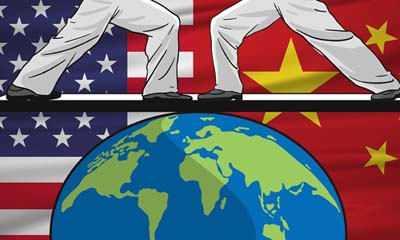
Can China, US coexist in Indo-Pacific region?
Zhu Feng – Global Times
Bonnie Glaser, director of the China Power Project at the Center for Strategic and International Studies (CSIS), told Japanese newspaper Nikkei Asian Review that, “It will be very difficult for the US and China to coexist peacefully in the Indo-Pacific.” But she also pointed out that, “It’s not impossible, but it’s highly unlikely that we (China and the US) will find a pathway to peaceful coexistence.”
Such remarks are unacceptable. Peaceful coexistence between great powers is the basic principle of international law. If major powers can’t coexist, it means that the conflicts between them are not only difficult to control, but also have high risks to move toward a military showdown.
Peaceful coexistence is a belief that a country should have and also a basic principle for dealing with relations between nations. The suggestion that China and the US cannot coexist peacefully in the Indo-Pacific region is too pessimistic. This has overstated the challenges that China’s rise may bring to the US.
It is a fact that China and the US already coexist in the Indo-Pacific region. But those so-called strategy elites in the US constantly make pessimistic projection like what Glaser had asserted. They think that China’s maritime power is rising rapidly, and that China’s naval power is bound to challenge that of the US. Therefore, the essence of the theory of “non-coexistence” reflects a hegemonic mentality that permeated US policy – they fret that they will lose their sole superpower status to China.
The coexistence of China and the US in the Indo-Pacific region is not a zero-sum scenario of a single winner or loser. Neither has to be on opposite sides – it’s not a sports game. The essential problem rests on the fact that the US does not have a strategic accommodation plan for China’s rise. This is deeply ironic because US interests are aligned by coexisting with China.
Washington identified Beijing as a strategic competitor in 2017. Since then, the US has aggressively deployed containment policies. The fundamental reason for this lies in that US strategy elites believe that the balance of power between China and the US has changed. They increasingly think that China will accelerate its endeavours, and the US will be stymied by new setbacks.
This “non-coexistence” logic also reflects anxieties in the US – especially fears wrought by the coronavirus epidemic. At present, the COVID-19 situation in the US is still worsening. Yet China is the first major country in the world that has realized economic recovery before the pandemic ends.
Under the impact of the pandemic, the balance of power between China and the US has changed in a way that is not favourable to the US. This is further causing US strategy elites to feel extremely anxious. Because of the worry about the decline of the US’ own strength, these people are increasingly focusing on bashing China and forming anti-China alliances.
The possibility of military conflicts or even war between China and the US has always been the focus of foreign media, scholars and observers. In recent years, the US has continuously strengthened military operations in the Indo-Pacific region. It has even reinforced military provocations against China. Under such circumstances, the current crisis management and control mechanisms of the two sides are obviously far from satisfactory.
The US is now continuously fortifying its military deterrence against China in the Western Pacific. Its military presence against China is also expanding. Coupled with the Trump administration’s high-profile and comprehensive suppression of China, the hostility between the two sides is constantly rising. Therefore, both sides need to be aware of the urgency of resuming military exchanges and communication at all levels as soon as possible. This will minimize the possibility of accidental collisions between China and the US.
Nevertheless, Washington is still trying to promote its Indo-Pacific Strategy, whose purpose is to continuously divide, isolate, and contain China. This mentality and practice of regarding the other side as the enemy is the fundamental reason that may aggravate the China-US conflict and make the two unable to peacefully coexist. The only true way for the two sides to coexist in harmony is to meet each other halfway.
The author is director of the Institute of International Studies under Nanjing University. opinion@globaltimes.com.cn
